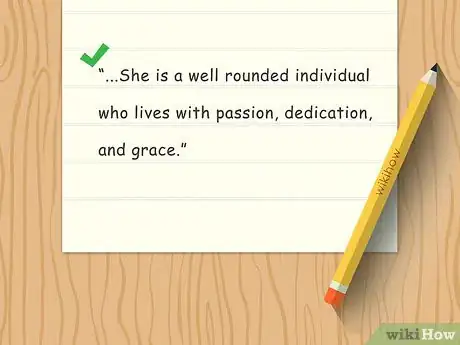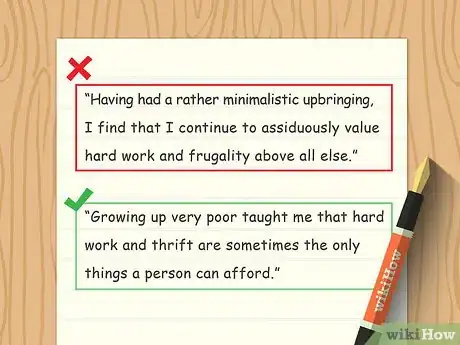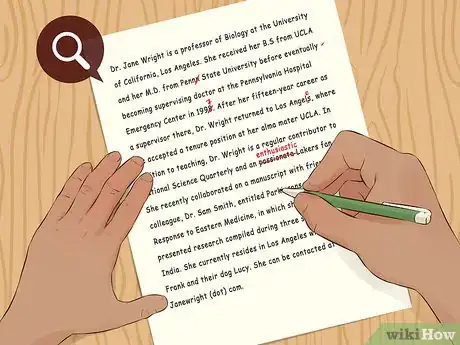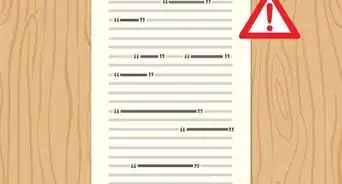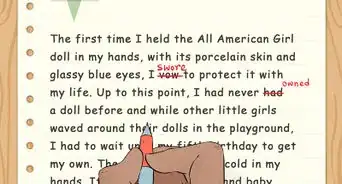This article was co-authored by Gerald Posner. Gerald Posner is an Author & Journalist based in Miami, Florida. With over 35 years of experience, he specializes in investigative journalism, nonfiction books, and editorials. He holds a law degree from UC College of the Law, San Francisco, and a BA in Political Science from the University of California-Berkeley. He’s the author of thirteen books, including several New York Times bestsellers, the winner of the Florida Book Award for General Nonfiction, and has been a finalist for the Pulitzer Prize in History. He was also shortlisted for the Best Business Book of 2020 by the Society for Advancing Business Editing and Writing.
There are 10 references cited in this article, which can be found at the bottom of the page.
wikiHow marks an article as reader-approved once it receives enough positive feedback. In this case, several readers have written to tell us that this article was helpful to them, earning it our reader-approved status.
This article has been viewed 538,930 times.
Writing a biographical sketch can help you learn about a figure’s importance and see the world through their eyes. Since you can’t cover a person’s entire life in a sketch, try to focus on their biggest accomplishments, then build the sketch around that. You can even use this technique to write about yourself!
Steps
Example Sketches
Researching Your Subject
-
1Choose a figure who interests you. Start by checking your assignment’s guidelines. They might require you to stick to a historical period, part of the world, or academic field. Browse textbooks, articles, and websites about the broader topic, and look for a figure who’s life appeals to you.[1]
- For example, suppose you need to write a biographical sketch of poet who lived in the 19th century. Look up poets you’ve covered in class, browse your textbook or anthology of poems, and search online for poets that fit your assignment.
- After reading his blurb in your anthology, you might be interested in learning more about Charles Baudelaire, so you choose him for your sketch.
-
2Search for books and articles at your library. Check you school or local library’s catalog for sources about your figure. Look for books and magazine, journal, and newspaper articles, and ask a librarian for help if you run into trouble.[2]
- For a major historical figure, you’ll probably have more results than you can handle. Search online for your historical figure and “authoritative biography” to find the most important sources.
- If you have trouble finding information about your subject, you might need to choose another option.
Advertisement -
3Look for reliable sources online. If you don’t have access to a library, you can still gather reliable sources online. Including “.edu,” “.gov,” or “.org” with your search terms often generates more credible results. While Wikipedia itself isn’t reliable, you could check the references on your figure’s page for links to credible sources.[3]
- If you’ve chosen a contemporary figure or famous person, searching online might be your best bet. The most credible sources would include reputable news publications, such as the BBC, The New York Times, and NPR.
-
4Gather primary and secondary sources. Primary sources might include an autobiography or letters your figure composed. Things your figure wrote aren’t necessarily trustworthy, so you’ll also need secondary sources, which are scholarly texts written about your figure.[4]
- You should be able to track down sources at your library or through its interlibrary loan program. If an autobiography or published collection of letters are available, you could also purchase them online or at a bookstore.
- To find good secondary sources, use search terms such as "authoritative" or "definitive biography" of your figure.
- When you find scholarly articles about your figure, check their footnotes or references. You'll definitely want to acquire a book or article about your figure that's referenced in lots of other sources.
-
5Review your figure’s life, achievements, and importance. Once you've done your research, ask yourself how the historical figure was shaped by their time period and environment. Think about how the historical figure impacted the lives of the people around them and future generations.[5]
- Figure out which of the figure's achievements, qualities, work, and life experience you want to emphasize.
Crafting an Autobiographical Sketch
-
1Explain what motivates you in a college or scholarship essay. If you're applying to college or for a scholarship, don't simply list your activities and accomplishments in your personal statement. Instead of writing that you've done something impressive, describe why you chose to undertake that challenge.[6]
- For example, writing, "My proudest moment is when I was elected class president," simply states that you're in student government.
- Instead, write why you wanted to be class president: "On a school trip to the state capitol, my congressperson described public service to my class. As they spoke, I remember looking up in awe at the capitol building's towering dome. However, it wasn't awe that inspired my interest in politics; it was the notion that governing is service."
-
2Tell a story that highlights a job's desired attributes or skills. If you need to write about yourself for a job application, read the qualifications listed in the position's description. Include details about experiences that helped you hone these attributes.[7] As is the case with a college or scholarship essay, tell a story about these attributes instead of merely listing them.[8]
- Suppose a job description lists the skill "Cost management." Writing, "I cut operating costs by 17% at my prior position," just restates a line on your resume.
- Instead, write in your bio, "The complex purchasing system at my last position was like a many-headed Hydra. For every challenge I solved, 2 more came my way. Ultimately, I managed to conquer the beast, consolidated our vendors, negotiated new contracts, and cut our spending by 17%."
-
3Keep your bio concise and focused. For a college or scholarship application, your personal statement will likely have 1 page limit. Professional bios are usually a maximum of 2 paragraphs. You can't cover your whole life story in that amount of space, so focus on the main point you want to convey to readers.
- Come up with a thesis as if you were writing about a historical figure. Instead of trying to cover everything you've ever done, focus on 2 or 3 key qualifications.
- Try summing yourself up in a thesis statement, such as "Jane Doe encountered hardships, but every pitfall provided an opportunity to grow." You don't have to include your thesis verbatim in your bio, but it can help you keep your writing focused.
Drafting Your Essay
-
1Come up with a concise thesis for your sketch. You can’t include all the information about a person’s life in a short biographical sketch. After researching your figure, choose a key detail for your sketch’s focus. Then write a sentence that sums up the main point you want to make about your figure.[9]
- A thesis statement for a biographical sketch could be, “The principal themes of Charles Baudelaire’s poetry are rooted in his experience of urban life in Paris and his 1841 voyage to India.”
- If you're writing about yourself, focus on the achievements you're proudest of or those that are most relevant to an application. Additionally, it's usually best to focus on more recent accomplishments.
-
2Map your essay’s structure with a skeleton outline. Outlining your sketch will help you choose a structure that effectively conveys your main point. Start with your thesis, then list the examples you’ll include to support your claim. Build your essay’s body by dedicated a paragraph to each example.[10]
- For instance, your outline might look like this:
I. Thesis: The principal themes of Charles Baudelaire’s poetry are rooted in his experience of urban life in Paris and his 1841 voyage to India.
II. Emerging urbanism in Paris
A. Describe city life in the 19th century
B. Discuss Baudelaire and tavern culture
C. Cite and analyze poetic elements: corruption of the city, melancholy, “Spleen”
III. Romantic voyage
A. Lay the context of the voyage in Romantic poetry
B. Discuss Baudelaire’s trip to India
C. Cite and analyze poetic elements: ships, the ocean, exoticism
- For instance, your outline might look like this:
-
3Introduce the subject and your sketch’s focus in the first paragraph. Grab your reader’s interest with a hook sentence, such as “From morbid death to ecstatic odes to nature, Charles Baudelaire’s poetry swings between thematic poles.” Then lay down your argument or main point about your figure, and map out your essay’s structure.[11]
- Your intro should let your reader know what to expect in the coming paragraphs. For instance: "Baudelaire's personal letters and journal entries detail his life in Paris and travel abroad. Analyzing examples from his body of work will demonstrate how these encounters with urbanism and exoticism laid the foundation of his poetry's principal themes."
- For an autobiography, summarize what makes you a winning applicant or state the main points you intend to make about yourself.
- If you're writing an autobiography in the third person, introduce yourself in the first paragraph: "Jane Doe is a postdoctoral research fellow at the University of Georgia."
-
4Provide details and supporting evidence in the body. The body is your meat of your essay. Discuss the parts of your figure’s life that are most important for your main point. Include references to sources that back up your claims and descriptions. Use vivid, clear language to make a convincing, interesting sketch of your figure’s life.[12]
- For the body an autobiography, describe the events that impacted on you, challenges you overcame, or occasions when you honed your skills.
- Keep in mind your entire personal bio might only be a paragraph. You might introduce yourself in the first sentence, and the "body" might be 2 or 3 sentences long.
-
5Choose strong, specific words. Avoid using words that are vague or don't serve a purpose. For example, consider the sentence, “Charles Baudelaire was an incredibly important poet." The word "incredibly" doesn't convey specific information.[13]
- A better sentence would convey exactly why Baudelaire was important. “Charles Baudelaire dismantled Romantic poetry’s unquestioned adoration of nature” is stronger and more specific.
-
6Restate your main points in the conclusion. "Tell them what you’ve told them” is a good way to think about a conclusion’s role. After making your case in the body, summarize your claims in the concluding paragraph. Restate your thesis and briefly remind the reader of the facts you’ve presented to prove your point.
Revising Your Draft
-
1Look for sentences that sound awkward or unclear. Read your work out loud, and mark any spots that sound awkward or funny. Look for places that should be expanded, clarified, or eliminated.[14]
- Check for any places that seem confusing or leave you guessing. If you're not sure what you meant by a statement, your reader will definitely be lost.
-
2Check for typos and errors. Make sure your work is free of spelling or grammatical errors. Correct any typos or other minor errors.[15]
-
3Make sure your sources support your claims. Check all of your sources and make sure you’ve represented them accurately. You shouldn’t just use a source for the sake of it; it should have a specific role in your description or argument. If you spot any places where you’ve taken a source out of context, revise your work.[16]
-
4Ask someone to read your draft and offer feedback. Have a friend, relative, or teacher read your work before you submit it. Choose at least 1 person to review your work who has a careful eye and knowledge of your figure. Ask them to mark any mistakes, to point out any inaccurate information, and if they recommend any changes.[17]
Community Q&A
-
QuestionShould I write the biosketch in paragraphs?
 Community AnswerIt's your choice. It is not required to be in paragraphs.
Community AnswerIt's your choice. It is not required to be in paragraphs. -
QuestionShould I write in third person if I'm writing an autobiographical sketch of myself?
 Community AnswerYou can write in first or third person, depending on whether you want to give off an impression of being distant from the "you" in the sketch. Write two versions and see which one you like better.
Community AnswerYou can write in first or third person, depending on whether you want to give off an impression of being distant from the "you" in the sketch. Write two versions and see which one you like better. -
QuestionShould I include illustrations in my biographical sketch?
 Community AnswerIt is not required as long as your description is appropriate. But yes, to make it look pretty, you can surely include some illustrations.
Community AnswerIt is not required as long as your description is appropriate. But yes, to make it look pretty, you can surely include some illustrations.
References
- ↑ https://penandthepad.com/write-impressive-biographical-sketch-4531922.html
- ↑ http://open.lib.umn.edu/writingforsuccess/chapter/11-4-strategies-for-gathering-reliable-information/
- ↑ http://open.lib.umn.edu/writingforsuccess/chapter/11-4-strategies-for-gathering-reliable-information/
- ↑ https://sccollege.edu/Library/Pages/primarysources.aspx
- ↑ http://www.readwritethink.org/classroom-resources/lesson-plans/writers-workshop-biographical-sketch-1039.html?tab=4#session1
- ↑ https://www.educations.com/articles-and-advice/motivation-letter-for-studies-abroad-13564
- ↑ http://www.cs.cmu.edu/~sfinger/advice/advice.html#biosketches
- ↑ https://www.forbes.com/sites/deborahljacobs/2014/06/03/what-to-do-when-you-need-a-bio-rather-than-a-resume/#65cc18a34e43
- ↑ http://www.readwritethink.org/classroom-resources/lesson-plans/writers-workshop-biographical-sketch-1039.html?tab=4#session1
- ↑ https://slc.berkeley.edu/you-start-writing-paper-guide-prewriting-techniques-0
- ↑ https://grammar.yourdictionary.com/grammar-rules-and-tips/tips-on-writing-a-biographical-sketch.html
- ↑ https://grammar.yourdictionary.com/grammar-rules-and-tips/tips-on-writing-a-biographical-sketch.html
- ↑ https://owl.purdue.edu/owl/general_writing/academic_writing/conciseness/index.html
- ↑ http://www.readwritethink.org/classroom-resources/lesson-plans/writers-workshop-biographical-sketch-1039.html?tab=4#session1
- ↑ https://penandthepad.com/write-impressive-biographical-sketch-4531922.html
- ↑ https://grammar.yourdictionary.com/grammar-rules-and-tips/tips-on-writing-a-biographical-sketch.html
- ↑ http://www.readwritethink.org/classroom-resources/lesson-plans/writers-workshop-biographical-sketch-1039.html?tab=4#session1
About This Article
Once you’ve chosen someone to write about in your biographical sketch, choose a key detail about the person’s life, then use that to write a thesis statement. Once you have your thesis, craft an outline made up of 4-5 facts that support your thesis statement. Then, start your essay by introducing the reader to your subject, then follow by describing your thesis and a brief summary of the rest of your essay. The body of your essay should describe facts from your subject’s life that support your thesis. For tips on choosing a figure for your sketch, keep reading!















